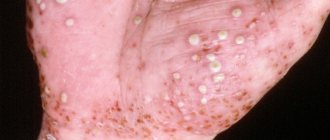The development of an allergic reaction can bring a large number of unpleasant sensations, to eliminate which it is necessary to carry out appropriate drug treatment. However, there are cases when an allergic reaction cannot be treated for a long time and can cause harm to a person’s health.
It is necessary to carry out a quick way to eliminate symptoms and very often special allergy ampoules are used for such cases. The use of injections allows you to quickly reduce the symptoms of the body’s reaction to the allergen and eliminate the likelihood of allergies for a long time.
Today, there are a large number of special injections against allergic reactions of varying levels of action; the advantages of such drugs over allergy pills are that the injection begins to act in a few minutes.
When are allergy injections prescribed?
The use of allergy ampoules is carried out by a medical professional.
Such injections are most often prescribed in the following situations:
- The presence of acute attacks of an allergic reaction;
- For cases where a person has a predisposition to acute exacerbations during a certain period of time to allergens;
- A large number of insect bites , the body’s reaction to the poison develops;
- If there are diseases in the body , the treatment of which can cause an acute allergic reaction;
- Swelling of the respiratory system.
The use of ampoules against allergies is prescribed in rare cases, most often when a reaction to an allergen is a threat to human life.
What is ASIT?
This is the only method of treating allergic diseases aimed at the very mechanism of development of pathological reactions. Its goal is not simply to relieve symptoms. ASIT reduces sensitivity to the allergen, which : • weakens the immune system's response to it; • prevents increased sensitivity to it; • helps achieve long-term remission; • limits the range of allergens that cause an acute immune response; • prevents the development of complications.
By suppressing the manifestations of household or pollen allergies, a person receives relief in the present. But symptomatic therapy will not protect him from the risk of developing bronchial asthma. Only ASIT gives this effect.
Mechanism of action
Using ampoules against allergies allows you to achieve quick results.
When drugs enter the body, they perform the following tasks:
- Analysis to identify the type of allergen - carried out to achieve the desired result before the injection;
- An additional dose of allergen is introduced into the human body , and an injection promotes enhanced functioning of the immune system to develop the body’s natural defenses;
- The drug is potent , so the active components quickly eliminate unpleasant symptoms and prevent their recurrence;
- The use of anti-allergy ampoules allows the active components to remain in the body for a long time and support the functioning of the body when in contact with allergens.
To eliminate unpleasant symptoms, it is enough to use just one injection, which will alleviate the person’s condition. Further treatment is carried out only on the recommendation of a doctor.
Kinds
Depending on the factor that activates the body's defense reaction, allergies are classified into three types. Please note that any treatment begins with reducing contact with the allergen, and the action of the drugs is mainly aimed at eliminating symptoms.
| View | Negative reaction to | Diagnostics |
| Food | Certain foods. | Provocative tests (injection of a concentrated allergen into the blood), skin tests. |
| Respiratory | Some smells, dust or blooms. | Familiarization with family history, observation. |
| Medicinal | Medications or long-term use. | People who regularly take hormonal and antibacterial drugs are at risk. Injecting a small dose of the drug into the blood. |
It is important to find out the cause of allergies at the initial stage, since at an advanced stage secondary diseases will begin to develop (bronchial asthma, eczema, sinusitis, etc.).
Review of drugs
The selection of the required allergy ampoule is made by a medical professional individually for each patient.
Before prescribing treatment, a person is assigned to undergo a special examination, which will identify all contraindications to such a procedure.
There are several types of ampoules containing hormones and non-hormonal types.
Non-hormonal drugs
Drugs against non-hormonal allergic reactions are aimed at developing the body's natural processes to combat allergens.
The human body gradually introduces an allergen to which the body develops a habit and does not show any symptoms. The active components of the ampoule allow you to strengthen the fight of the immune system for a long time.
Such injections help to completely eliminate allergies, however, they require a special course of treatment.
Antiallergic injectable drugs
They are used in cases of hypersensitivity of the human body, and with the rapid development of allergic symptoms.
They are most often used for cases where conventional antihistamines do not cope with the allergic reaction.
The following medications are most often prescribed.
Diphenhydramine
It is used for a long time and allows you to quickly reduce the manifestation of allergies; a doctor’s prescription is required for use.
Eliminates the following symptoms:
- Swelling;
- Itching;
- Inflammation;
- Disturbances in the breathing process;
- Increased tear production.
Used for cases of moderate and mild allergic reactions, when conventional medications in tablet form do not bring the desired result.
Prescribed in the following situations:
- Presence of shock;
- Food reaction of the body;
- Conjunctivitis;
- Acute swelling.
The drug has the following types of contraindications:
- Individual intolerance;
- Pregnancy;
- Alcoholism;
- Disease of the digestive organs;
- Age up to 5 years;
- Glaucoma.
When using the ampoule, the following side effects may occur:
- Disturbances in the breathing process;
- Nervousness;
- Rash on the body and redness of the skin;
- Cramps.
Treatment with this type of drug is carried out depending on the severity of the disease, but not less than 5 days. A repeat course is possible if necessary.
The average cost of Diphenhydramine ampoules is 40 rubles per piece.
Suprastin
Injection capsules are prescribed to eliminate a reaction to an allergen, and have the ability to quickly spread throughout the body and reduce the manifestation of unpleasant symptoms.
The use of the ampoule is contraindicated:
- Bronchial asthma;
- Individual sensitivity;
- Pregnancy;
- Children under 3 years of age;
- Nervous system disorder.
Appointed:
- Onioneurotic edema;
- Seasonal rhinitis;
- Acute eczema;
- Acute dermatitis;
- Allergic reaction to food and medicinal forms.
Used to reduce swelling and other types of allergic reaction symptoms.
It is not recommended to use ampoules for patients who drive a vehicle. The use of the Suprastin ampoule is prescribed for a course of no more than 7 days.
The average cost is 120 rubles .
Tavegil
Substance in glass ampoules, the action of which has antihistamine and anti-inflammatory effects. Eliminates the sensation of itching, reduces the formation of swelling of soft tissues.
Indications for use:
- Preventive treatment of seasonal exacerbations of allergies;
- Swelling;
- State of shock;
- After a blood transfusion to eliminate antibodies.
Contraindications:
- The period of bearing a child;
- Age from 3 years;
- Bronchial asthma;
- Stomach disease;
- Intravenous pressure.
For adults, one ampoule is prescribed intravenously per day; the duration of treatment is determined individually by the doctor. For children, the recommended dose is 0.025 mg, divided into two doses.
The course of treatment is no more than 5 days. Before administering the drug from the ampoule, it is necessary to first dilute the substance with glucose.
If it is necessary to repeat the course of treatment, it is necessary to wait a break of at least 2 months. The duration of the result depends on the individual characteristics of the person.
The average cost is 200 rubles .
Desensitizing drugs
Aimed at reducing the body's sensitivity to irritants, it is most often used to reduce acute forms of skin allergies.
Calcium gluconate
The use of ampoules is prescribed for intramuscular administration to adults, intravenously for children over 2 years of age, to eliminate acute allergy symptoms.
Indications for use:
- Swelling of the skin;
- Conjunctivitis;
- Inflammatory formations on the skin;
- Itching;
- A large rash on the skin and mucous membranes.
Contraindications:
- Thrombosis;
- Malfunction of the kidneys;
- Excess calcium in the body;
- Pregnancy and breastfeeding.
The dosage of the drug consists of 500 mg per day for an adult. For children, no more than 250 mg is used, depending on age.
The course of treatment is no more than 14 days; if necessary, the injection can be repeated after a break of at least 2 months.
The average cost of ampoules is 60 rubles .
Detoxification ampoules
The action of such drugs is aimed at removing toxins and poisonous substances from the body, to which an allergic reaction occurs.
Rheosorbilact
It has an effect aimed at removing toxins from the human body and increases blood circulation in the body.
Indications for use:
- Blood intoxication;
- State of shock;
Contraindications:
- Children under 12 years of age;
- Pregnancy;
- Hemorrhage;
- Dehydration
Used for allergies to eliminate swelling and eliminate external symptoms of allergies. Used intravenously once a day for three days.
The average cost is 300 rubles .
Ascorbic acid
The action of the ampoule with the substance is aimed at strengthening all organs and improving the protective organs of the immune system. It is recommended to use as an additional remedy in the treatment of allergies.
Indications for use:
- Presence of toxins in the body;
- Reduced immunity;
- Anaphylactic shock;
Contraindicated for people who suffer from individual glucose intolerance.
It is prescribed individually for each patient intramuscularly once a day for 5 days. For children, it is recommended to use the product in powder, which is diluted with water.
The average cost of ampoules is 60 rubles .
Diuretics
Prescribed as injections to accelerate fluid circulation in the body. Due to this, all harmful substances are removed from the body and swelling of the skin is reduced.
Contraindications:
- Malfunction of the kidneys;
- Children under 10 years of age;
- Pregnancy;
- Disease of the urinary system.
The course and duration of use of injections with a diuretic effect are prescribed as additional therapy to the use of antihistamine ampoules, depending on individual cases of the disease.
It is not recommended to use ampoules with diuretics for a long time; an imbalance in the water balance and malfunctions in the functioning of internal organs may be observed.
Hormonal drugs
The use of ampoules against hormonal-type allergies is prescribed for cases where the body's reactions manifest themselves as severe symptoms and can threaten a person's life.
The active components of the ampoule reduce the permeability of blood vessels, thereby reducing the spread of allergens throughout the body.
If conventional anti-allergy medications do not help, special ampoules are prescribed to relieve symptoms; the duration of use is determined by the doctor individually for each patient.
Among the hormonal drugs, the following drugs are most commonly used.
Diprospan
Used to suppress reactions from exposure to allergens and reduce external symptoms.
Indications for use:
- Anaphylactic shock;
- Acute forms of urticaria;
- Drug allergy;
- Asthma;
- Conjunctivitis;
- Food allergies.
Eliminates symptoms of swelling and inflammatory formations on the skin and mucous membranes.
Contraindications:
- Stomach diseases;
- Viral diseases;
- Tuberculosis;
- Pregnancy;
- Age up to 12 years.
The drug is administered intramuscularly for 7 days. The course of treatment can be increased if necessary, repeated treatment is carried out in case of urgent need no earlier than after 4 months.
The effect of using such an anti-allergy ampoule is long-lasting and can last for more than a year.
The average cost is 450 rubles .
Prednisolone
The action of the ampoule against allergies is aimed at quickly eliminating symptoms and developing natural immune processes to combat irritants.
Indications for use:
- Drug allergy;
- Bronchial asthma;
- Hay fever;
- Swelling of the skin and itching.
Contraindications:
- Myopathy;
- Stomach diseases;
- Poliomyelitis virus;
- Pregnancy;
- Kidney disease;
- Diabetes mellitus;
Eliminates symptoms that manifest as swelling and skin rashes in large quantities.
Used from the age of 7 years 2 mg per kilogram of weight. Adults are prescribed 90 mg intravenously. The course of treatment does not exceed 10 days.
The average price of ampoules is 150 rubles .
Hydrocortisone
The drug has an anti-inflammatory and antihistamine effect on the body. Eliminates burning and rashes on the skin, relieves swelling and tearing.
Indications for use:
- Dermatitis;
- Swelling of the skin due to allergies;
- Toxidermy;
- Food and drug reactions;
- Chemical poisoning.
Contraindications:
- Age up to 2 years;
- Individual sensitivity to the substance;
- Viral type disease;
- Nephritis;
- Kidney disease;
- Blood clots in blood vessels;
- Pregnancy;
- Advanced age.
Method of administration for adults: 300 mg intravenously once a day, the course of use is prescribed depending on the type of disease. Children are given 25 mg per day intramuscularly, starting at 2 years of age and gradually increasing, depending on age. Adults are given 40 mg per day.
The average cost is 180 rubles .
Dexamethasone
It has anti-inflammatory, antiallergic desensitizing, antishock, antitoxic and immunosuppressive effects.
Indications for use:
- Anaphylactic shock;
- Quincke's edema;
- Asthmatic, severe bronchospasm;
- Severe allergic reactions;
- Acute severe dermatoses.
Contraindications:
- Osteoporosis;
- Pregnancy and lactation;
- Acute psychoses;
- Active form of tuberculosis;
- Kidney failure;
- Liver cirrhosis and chronic hepatitis;
- Blood clotting disorders;
- Peptic ulcer of the stomach and duodenum.
To prepare a solution for intravenous infusion, physiological sodium chloride solution or 5% dextrose solution is used as a solvent.
The dose of the drug for the treatment of acute allergic reactions in children and adults is calculated individually, based on the body weight and general condition of the patient.
The average cost is 90 rubles .
The use of hormonal drugs has a large number of side effects that require special study before using anti-allergy ampoules.
An incredible success story
Not more than six months ago, Circassia, a company created at the University of Oxford, presented stunning results from the second phase of clinical trials of a synthetic polypeptide vaccine for cat allergies. (The model, methods and results of the clinical study can be found in detail in the original article [6].) The ability of the developed Tolero Mune vaccine to eliminate the factors that shape the disease as a whole is three times higher than that of all currently known drugs, including antihistamines and steroid drugs . The first significant results were observed in a year-long study of the effect of just four injections administered over 12 weeks (one injection every three weeks) [1].
The vaccine received even more attention when the results of a two-year study became known - a 50% relief of nasal and ocular allergy symptoms on the total index of rhinoconjunctival symptoms (TRSS) (the result of placebo was only 14.9%).
Even in the “extreme” four-day study, Tolero Mune did not disappoint: the improvement was 38.3% (13.4% for placebo). According to Steve Harris, head of Circassia, these are unprecedented results not only for allergology, but also for immunology in general.
What is a hot shot?
Hot injection refers to the use of special substances for injection, during which the patient feels a feeling of heat and burning. This feeling appears due to the large amount of salts contained in the injection.
Features of such injections:
- Calcium Gluconate and Calcium Chloride are used for injection;
- During the administration of the solution, blood vessels dilate , thereby increasing blood circulation;
- The active components of calcium quickly spread throughout the body and reduce allergy symptoms.
These types of injections are used in cases where the previous treatment did not provide the necessary results and urgent relief from symptoms is required.
Contraindicated for use during pregnancy, childhood and people over 60 years of age.
Carrying out such an injection causes discomfort in the patient and may cause side effects. The solution must be injected slowly, otherwise skin necrosis may occur.
Advantages and disadvantages of allergy ampoules
Like any type of medicinal substance, the use of ampoules against allergies has its advantages and disadvantages.
| Advantages | Flaws |
| Possibility of using ampoules at different levels of disease intensity. | Some drugs have a hypnotic effect (Diphenhydramine, Suprastin) |
| Improving the functioning of the immune system. | The appearance of a large number of side effects. |
| Long-lasting protection against allergies. | Hormonal ampoules have many contraindications for use. |
| Can be used as prophylaxis. | |
| Reducing the need to use large quantities of medications. | |
| Quick effect. |
All types of ampoules against allergies are divided into three types:
- First generation substances that do not have a long-term effect, for example, Suprastin and Diazolin. They can also negatively affect the functioning of the heart muscle;
- Second generation substances - can be used for a long time, however, they have a sedative effect on the body and require medical supervision;
- Third generation substances are effective in eliminating allergies and provide long-lasting results.
To determine the type of drug, you need to consult a doctor who will tell you all the disadvantages and advantages and help you correctly prescribe an ampoule for the treatment of allergies.
Is the nature of the vaccine an obvious failure or a brilliant idea?
Synthetic vaccines are produced chemically in vitro. Despite the complete copying of the amino acid sequence of the allergen protein, they are characterized by low efficiency and require the addition of an additional immunogenic component - an adjuvant. It is not surprising - after all, how closely the antigen and antibody become friends largely depends on the spatial structure of the protein, and not just on the chemical composition. Synthetic proteins are linear, which ruins their chances of becoming a good vaccine.
The ToleroMune vaccine does not even contain an adjuvant. The idea seems to be a complete failure from the very beginning, but how did the vaccine creators achieve such significant results?
The idea of using allergen epitopes as a vaccine was risky, but brilliant. They are very small linear peptides and are bound by immature antigen-presenting cells. Due to the presence of a constant “allergenic” background, T-helper 2 cells do not respond to every allergic attack with abundant production of IgE antibodies, and the cascade of reactions involving mast cells (as well as their biosynthesis) gradually loses its former intensity, and allergy symptoms do not develop. It is not the “interception” of already synthesized IgE antibodies that occurs, but the cessation of their synthesis in principle. Bravo!
Briefly, the technology for creating the Tolero Mune cat allergy vaccine looked like this:
- Initially, those epitopes of the cat allergen (Fel d1) were identified that bound to molecules of the major histocompatibility complex II (the ten most common HLA-DR receptors) on the surface of APC and caused a reaction of T-lymphocytes [6] (Fig. 2).
- After this, the epitopes were obtained in vitro by solid-phase peptide synthesis using the F-moc protective reaction and an in vivo test was performed to select those epitopes that attract T-helper 2 (Th2) cells responsible for the production of IgE antibodies. In addition, the histamine release factor was assessed for each of the epitopes (Fig. 3).
- From the “elite” they formed a vaccine - a set of seven peptides, each of which contains one or two Th2-activating epitopes.
Figure 2. Complete epitope map of the Fel d1 allergen. The regions of binding to MHC II are highlighted by shading.
[6]
It turns out that the vaccine from Oxford scientists immediately eliminated the main disadvantages of ASIT:
- The absence of an adverse reaction similar to the disease itself, as is the case with the use of a whole allergen.
- Significant reduction in treatment time and easier administration - just four injections over 12 weeks. Alternative treatment regimens and dosage forms are also currently being developed.
- The synthetic route for obtaining the vaccine makes it possible to reduce its cost and make it available to a larger number of patients.
Figure 3. Plot of histamine release as a function of the nature of the epitope. It shows that for all synthesized epitopes the factor is significantly lower than that of the whole cat allergen extract.
[6]
All of the above is a huge help to people who suffer from allergies constantly: during the flowering of trees and grasses, every time they encounter a cat or dust...
Long acting allergy shots
Very often special ampoules are used for long-acting injections, which are aimed at reducing the body's reaction to allergens.
The principle of operation of these types of ampoules is the gradual adaptation of the body to allergens and the development of immunity against the influence of environmental factors.
The duration of the result from the ampoule depends on the individual characteristics of the body, and can vary from several months to several years. There are cases when a person completely eliminates the reaction to a certain type of allergen.
The following indications for the use of long-acting injection ampoules are:
- Allergenic conjunctivitis;
- Bronchial asthma;
- Atopic dermatitis;
- Hay fever.
Contraindications:
- Increased sensitivity;
- Stomach disease;
- Diabetes;
- Tuberculosis;
- Age up to 12 years;
- Pregnancy.
The use of long-acting anti-allergy ampoules can cause a large number of side effects, which include:
- Stomach upset;
- Sudden weight gain;
- Osteoporosis;
- A sharp decrease in immunity;
- Mental disorders;
- Development of cataracts;
- Abscesses on the skin.
The use of such procedures is carried out strictly under the supervision of a doctor and in individually selected dosages.
The advantages of such injections:
- There is a chance to reduce the occurrence of allergies in the future;
- The effect of the ampoule has a long period;
- Allows you to reduce the manifestation of symptoms of severe types of reaction;
- The number of drugs used, which also negatively affect human health, is being reduced.
Disadvantages of such injections:
- They tend to cause unpleasant side effects;
- Not suitable for all patients;
- Not used during pregnancy;
- May cause skin rashes.
There are several ways to administer such solutions:
- The classic method is used to gradually get the body accustomed to the allergen. The injection is administered several times a month for three months;
- A quick method is to use an injection two to three times a day. The course of treatment lasts up to three weeks. It is recommended to use when there is an urgent need for action on the body, for example, during the flowering season of vegetation.
To obtain a more lasting result, it is necessary to gradually introduce the allergen, and use courses of using antiallergic ampoules as prophylaxis.
You are wrong to call him adorable! *
* — quote from the movie “Heart of a Dog.”
The main disadvantage of ASIT is currently related to the origin of the drugs used. All of them are extracts from natural allergens. Despite the overall positive outcome of therapy, the side effects of such drugs remain significant. This is due to the fact that the target of the “whole” allergen, not processed by APC, is the immunoglobulin “antennas” of mast cells, and the entire cascade of allergic reactions starts anew, provoking an immune response similar in nature to the disease itself, but in a lighter form, which corresponds to the dose of the administered allergen .
In addition, there are some doubts regarding the quality and origin of allergy vaccines offered by medical institutions. It is not surprising, because even for the allergens underlying “manufactured” drugs, there are no generally accepted standards and criteria that determine the effect of the drug. The measure of effectiveness is the titer of IgE antibodies produced by the body. It turns out that the parameters of the immune system of a given organism are measured, and not the active substance (see pharmacokinetics, pharmacodynamics). Of course, there are statistics, but still such drugs remain empirically effective.
Also significant imperfections of ASIT are its duration and inconvenience - as a rule, treatment is a course of injections with different frequencies (from three times a week to once a month) or a tablet daily, and all this for three to five years.
It is impossible not to mention the high cost of therapy, which makes its implementation impossible for many people.
Should I choose tablets or ampoules?
The use of products in the form of tablets is recommended for cases where the body’s reactions to external factors manifest themselves in a mild form and are treatable.
Experts also recommend the use of tablets at an early age, since the drug in tablet form has a lower dosage and has a more positive effect on future health.
For cases where special medications do not help and the allergy threatens a person’s life, it is necessary to use substances in ampoules. The duration of treatment and intensity should be selected individually by the doctor.
Injection therapy
If the patient has recently undergone surgery in the mouth or has an acute dental disease, the sublingual method will not be suitable for him. In this case, they resort to injections.
The following can be administered: • water-salt extract of the allergen; • allergoid obtained by polymerization of an allergen; • allergen purified in a suspension of aluminum hydroxide or calcium phosphate.
Clinical recommendations provide approximate regimens (doses and frequency of injections). However, they are adjusted based on personal tolerance. During the period of peak concentration of the trigger, injections are not carried out.
Possible side effects
Any hyposensitizing drug contains an allergen, albeit in small doses. It is difficult to predict how the body will react to its penetration. Regardless of the method chosen, the following systemic reactions : • exacerbation of allergy symptoms (sneezing, itching, lacrimation, cough, runny nose); • difficulty breathing; • skin rashes; • temperature increase up to 38 degrees; • headache; • aching joints.
Life-threatening conditions rarely occur (with the sublingual method they are not observed at all), but they cannot be completely excluded. These include laryngeal edema and bronchospasm, anaphylactic shock.
With the injection method of treatment, local reactions are also possible. The injection area often swells, turns red and itches. In this case, antihistamines will help.
Advantages of the method
The discovery of hyposensitizing drugs has made life easier for allergy sufferers. Not all triggers can be avoided: house dust forms all year round, trees dust “on a schedule.” An effective treatment method has allowed people with an acute immune response to own pets.
ASIT has significant advantages over taking antihistamines: • stable and long-lasting results; • prevention of severe complications (especially bronchial asthma); • reducing the need to take medications; • general improvement in quality of life. Many patients note that they are approaching recovery. In 80% of cases, remission is achieved for 10 years or more. In 5% of those treated, allergic reactions no longer occurred.
Disadvantages of the method
Despite the proven advantages of allergen-specific immunotherapy, it also has disadvantages: • Difficulty in determining the dose. It is important to maintain a balance between the expected result and safety. • Possible adverse reactions. They often manifest themselves in mild and moderate forms, but they can also be quite serious. • High prices. The drugs seem quite expensive, but the costs are offset by savings on antihistamines.
A temporary disadvantage is the limited action of ASIT: for now it covers a small list of allergens. However, research in this direction continues. If a cure for certain types of allergies is found, then in the future there is a chance to defeat this phenomenon completely.
When are they prescribed for children?
The use of ampoules with anti-allergy substances in children is permissible from 5 years of age.
At earlier ages, the use of such ampoules can be prescribed strictly on an individual basis if there is an urgent need.
Injections are used in a reduced dosage and require special monitoring of the child’s well-being.
The most commonly used ampoules are Suprastin and Diprospan; before administering the injection, it is recommended to test the child’s sensitivity to the drug.
To do this, a small dose is administered and the reaction is monitored. If the child’s body does not show any symptoms, the rest of the ampoule is administered.
Literature
- Randy Osborne. (2013). Synthetic peptide allergy vaccine shows efficacy. Nat Biotechnol
.
31 , 371-372; - Ilyina N.I. and Kurbacheva O.M. (2004). Vaccine prevention of allergies. Vaccinal prevention of non-communicable diseases. 4;
- “Type I hypersensitivity reactions—mast cells and basophils.” Immunonfo.ru;
- Royt A., Brostoff J., Meil D. Immunology. M.: Mir, 2000. - 592 pp.;
- Vaccines in questions and answers;
- Margitta Worm, Hae-Hyuk Lee, Jörg Kleine-Tebbe, Roderick P. Hafner, Paul Laidler, et. al.. (2011). Development and preliminary clinical evaluation of a peptide immunotherapy vaccine for cat allergy. Journal of Allergy and Clinical Immunology
.
127 , 89-97.e14.
The use of drugs in ampoules during pregnancy
The occurrence of allergies during pregnancy requires urgent treatment.
Otherwise, there is a risk that the baby will develop symptoms after birth.
However, the period of gestation excludes the use of any medications, including anti-allergy ampoules.
This is explained by the fact that when they enter the bloodstream, the substances contained in the ampoule quickly spread throughout the body.
May disrupt the natural process of fetal development.
For cases where the use of an injection is an urgent need, ampoules with a non-hormonal substance are used. The use of hormones disrupts the development of the baby's internal organs and can contribute to premature birth.
However, experts advise using traditional medicine and drugs such as Claritin and Fenistil, which are allowed to be used during pregnancy.
Can you be allergic to an injection?
An allergic reaction may occur from the contents of the ampoule:
- for the individual reaction of the body has not been previously carried out
- if the drug was administered in large quantities or of poor quality.
In all other cases of treatment, no symptoms should occur. In individual cases, swelling may occur at the injection site and the appearance of small small formations, which most often go away on their own after a short time.
Sometimes the use of long-acting injections can cause the formation of a rash if the correct amount of allergen that is injected into the person has not been calculated.
However, when procedures are performed by specialists, the occurrence of such cases is rare.
Recommendations
Experts advise people with allergies to follow the following recommendations:
- Closely monitor your health and identify the allergen;
- Reduce the likelihood of contact with an allergic substance;
- Eat healthy and lead an active lifestyle;
- Drink plenty of water;
- Do not use medicinal substances without a doctor’s prescription;
- In case of exacerbation of allergies, consult a doctor to prescribe special medications;
- If there are no results from treatment, use special anti-allergy ampoules after visiting a doctor.
Symptoms
Signs of an allergy can occur upon contact with the source of the allergy or during prolonged accumulation of the irritant in the body. The first option is most often found in children, since their immunity is not yet fully adapted to environmental influences.
Let's look at the main signs of allergies by category in the following table.
| From the outside | Manifestations |
| Respiratory organs | Dry cough or sore throat, swelling of the pharynx, difficulty breathing. Sneezing, mucus discharge from the nasal passages, nasal congestion, which can develop into chronic rhinitis, rhinosinusitis, tracheitis. |
| Circulatory system | Changes in the number of leukocytes. The appearance of hives, eczema and other skin rashes. |
| Gastrointestinal tract (allergic enteropathy) | Dehydration, upset stomach, nausea or vomiting. |
| Mucous eye | Lacrimation, allergic conjunctivitis (both primary and secondary). |
In rare cases, allergies manifest themselves in the form of loss of consciousness, anaphylactic shock, Quincke's edema, etc.
Such symptoms are not always the result of an allergy. In order to make an accurate diagnosis, consult your doctor, he will refer you for tests.











